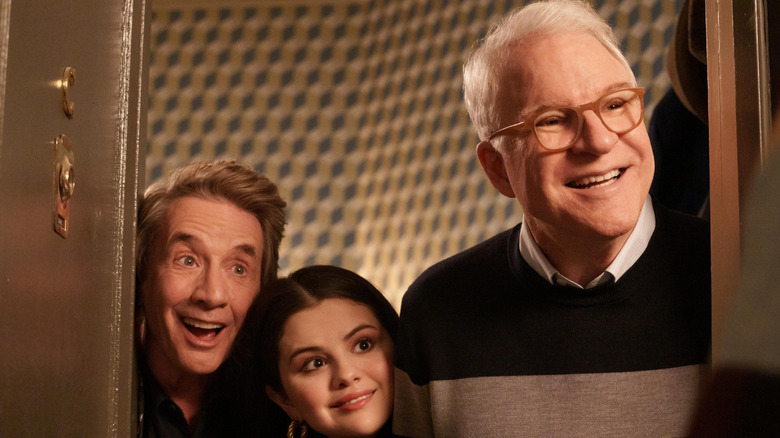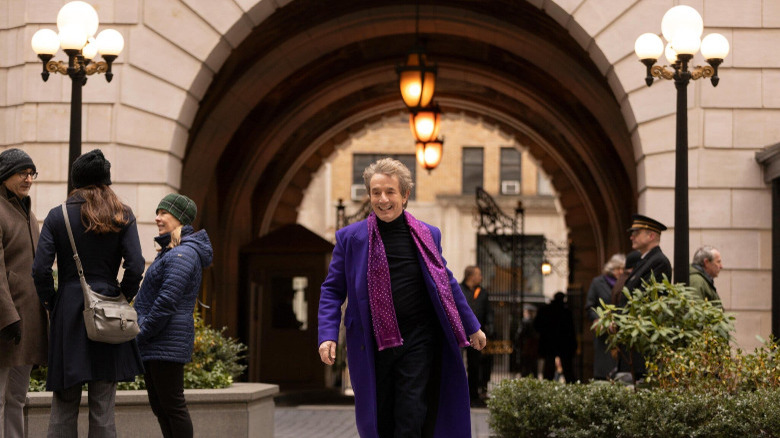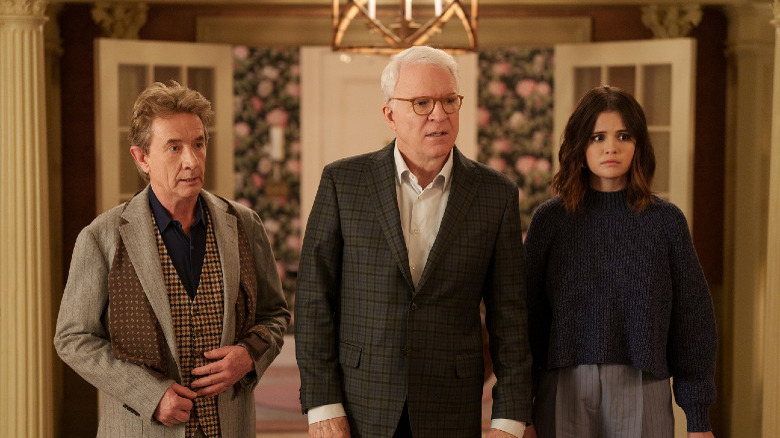The Scandalous Real-Life Building That Inspired Only Murders In The Building
How many murders can a single building contain before the authorities close it down? As of this writing, the Arconia on "Only Murders in the Building" is up to two — well, three if you count Zoe Cassidy falling off the roof ten years prior to the show's events. But if you think that's bad (which, y'know, it is), it's got nothing on the scandalous history of the real-life New York City edifice that inspired the place that Charles-Haden Savage, Oliver Putnam, and Mabel Mora call home.
"Only Murders in the Building" season 2, episode 2, "Framed," shines a light on the Arconia's shady past, dating back long before Zoe's death. The episode reveals the building's architect — the grandfather of recently-deceased Arconia board president Bunny Folger — added some secret elements of which only he was aware, including a hidden elevator he utilized to be a peeping Tom (spying on women as they dressed in their rooms via peepholes in the walls). This mustached creep and so-called "playboy," as noted by Vanity Fair, seems to be loosely based on one William Stokes, the Phelps-Dodge mining company heir and founder of a notorious luxury apartment building that takes up a block on Broadway between 73rd-74th Street.
That would be the Ansonia, an establishment whose name is tellingly only two letters removed from "Arconia." The Belnord in Manhattan, which has its own sordid backstory, is filmed for the exterior shots of the Arconia's facade, yet the Ansonia is far more similar in terms of its seedy history and the eclectic, colorful residents who've lived there since it finished construction in 1904 (seven years after Stokes hired architect Paul Emile Duboy to design it). Overall, though, life in the Arconia is relatively calm compared to the chaos that Stokes brought down upon the Ansonia.
The strange and skeevy tale of William Stokes
William Stokes, like Arconia resident Teddy Dimas on "Only Murders in the Building," came into his fortune in a, shall we say, less-than-scrupulous manner. After successfully winning a million-dollar lawsuit against his brother after the death of their father, Stokes turned his attention to the real estate market on the Upper West Side. This led to him buying land that was previously part of the New York Orphan Asylum, all in the name of building the "grandest hotel in Manhattan." Even Ebenezer Scrooge only went so far as to refuse to donate money to help impoverished orphans, as opposed to snatching their home out from under them! (And unlike that miser in "A Christmas Carol," Stokes was never terrorized into changing his ways by a pack of specters.)
As if that wasn't terrible enough, the then-42-year-old Stokes also married socialite Rita Hernandez de Alba de Acosta when she was only 15 years old in 1895. Six years and one child later, the pair divorced, with Rita allegedly securing $2 million in cash and $36,000 annually in alimony (apparently a record settlement for the time). Nearly two decades after that, Stokes' second wife, Helen Blanche Ellwood, divorced him after telling the judge about one of his dirty secrets — that he'd been hiding animals illegally at the Ansonia after being forbidden to do so by the Department of Health in 1907. Prior to that, Stokes kept as many as 500 chickens on the building's roof to provide residents with daily fresh eggs, as well as multiple geese, pigs, goats, ducks, seals, and, yes, a small-ish bear.
Scandals, scandals, and more scandals
Somehow, that's not the end of Williams Stokes' scandals at the Ansonia. He was also shot three times by his mistress — a vaudeville showgirl named Lillian Graham — after she claimed he attacked her while trying to retake the love letters he'd sent her (Stokes asserted she shot him because he refused to pay her blackmail money). On top of that, he may have murdered infamous racketeer Albert J. Adams two years after inviting him to move into the Ansonia. So said the coroner who inspected Adams' corpse before later ruling Adams had died by suicide. Not at all suspicious.
Stokes eventually died from pneumonia in 1926, just four days before turning 74. His New York Times obituary estimated what remained of Stokes' will would have almost certainly been wiped out, had he lost all the pending lawsuits against him prior to his death. As such, his son, who inherited the Ansonia, quickly sold the building to a not-so-trustworthy landlord who led it into bankruptcy before being sent to prison. By the time it was put on auction, the hotel had fallen into such disrepair that a small-time sign maker named Jacob Starr was able to buy it for only $50,000.
There's even more to the Ansonia's wild history (like how it housed a popular gay bathhouse in the 1960s), but much of it has yet to provide any clear inspiration for "Only Murders in the Building." Still, given what season 2 has already revealed about not just Bunny's creeper grandfather but also Charles' deceitful, unfaithful father and his own scandals in connection to the Arconia, it seems the ghost of William Stokes looms heavy over the show in its second outing.
New episodes of "Only Murders in the Building" drop Tuesdays on Hulu.


